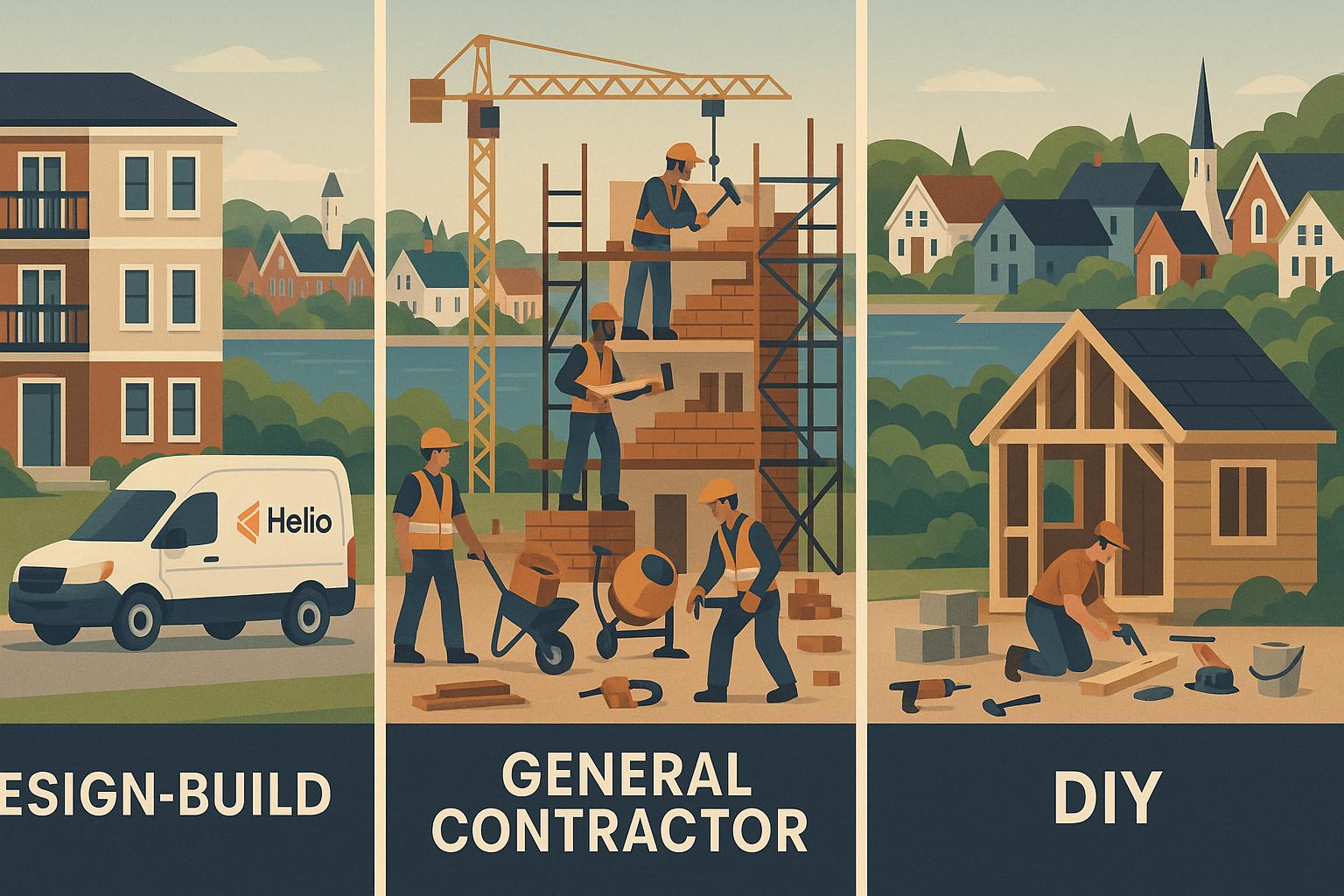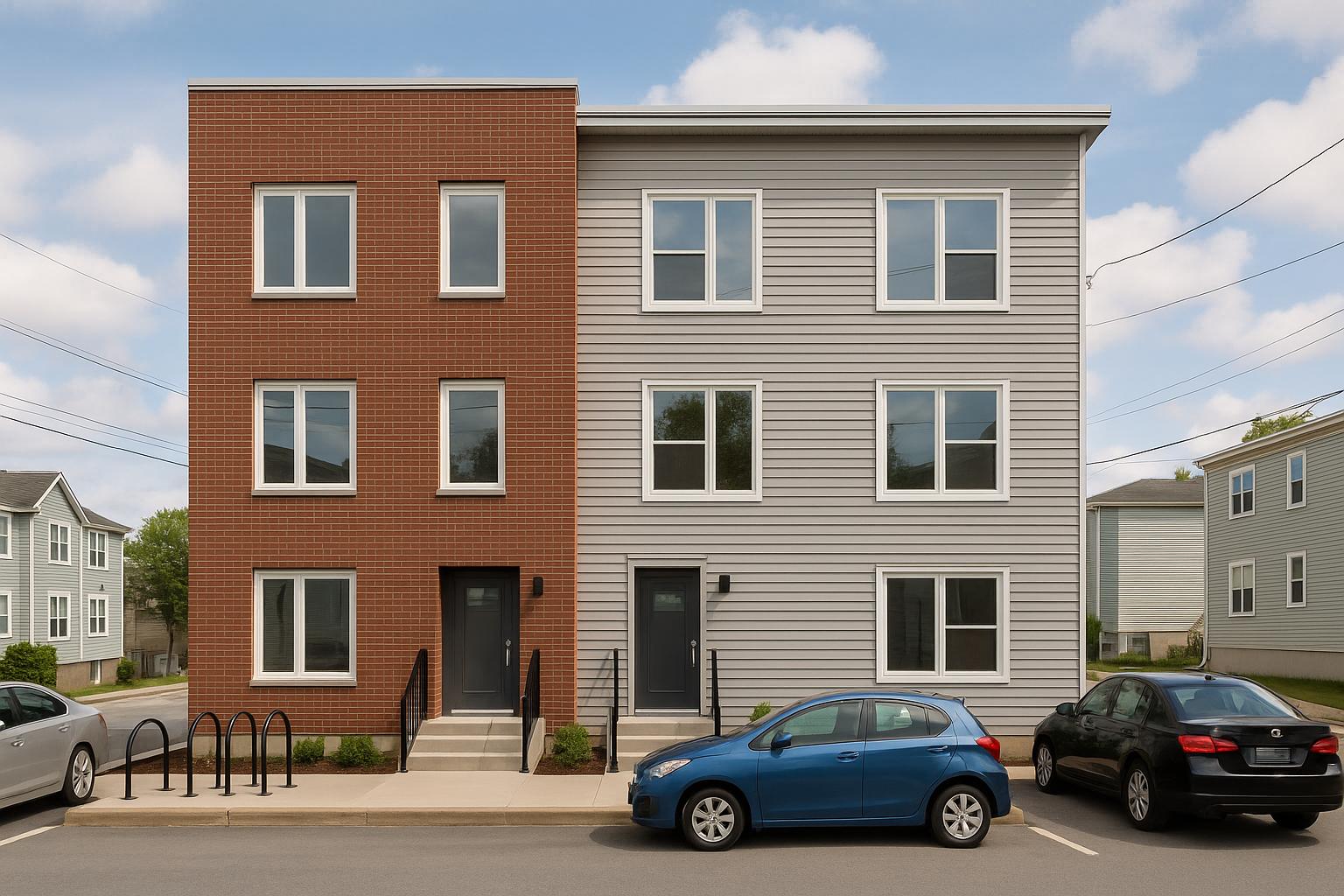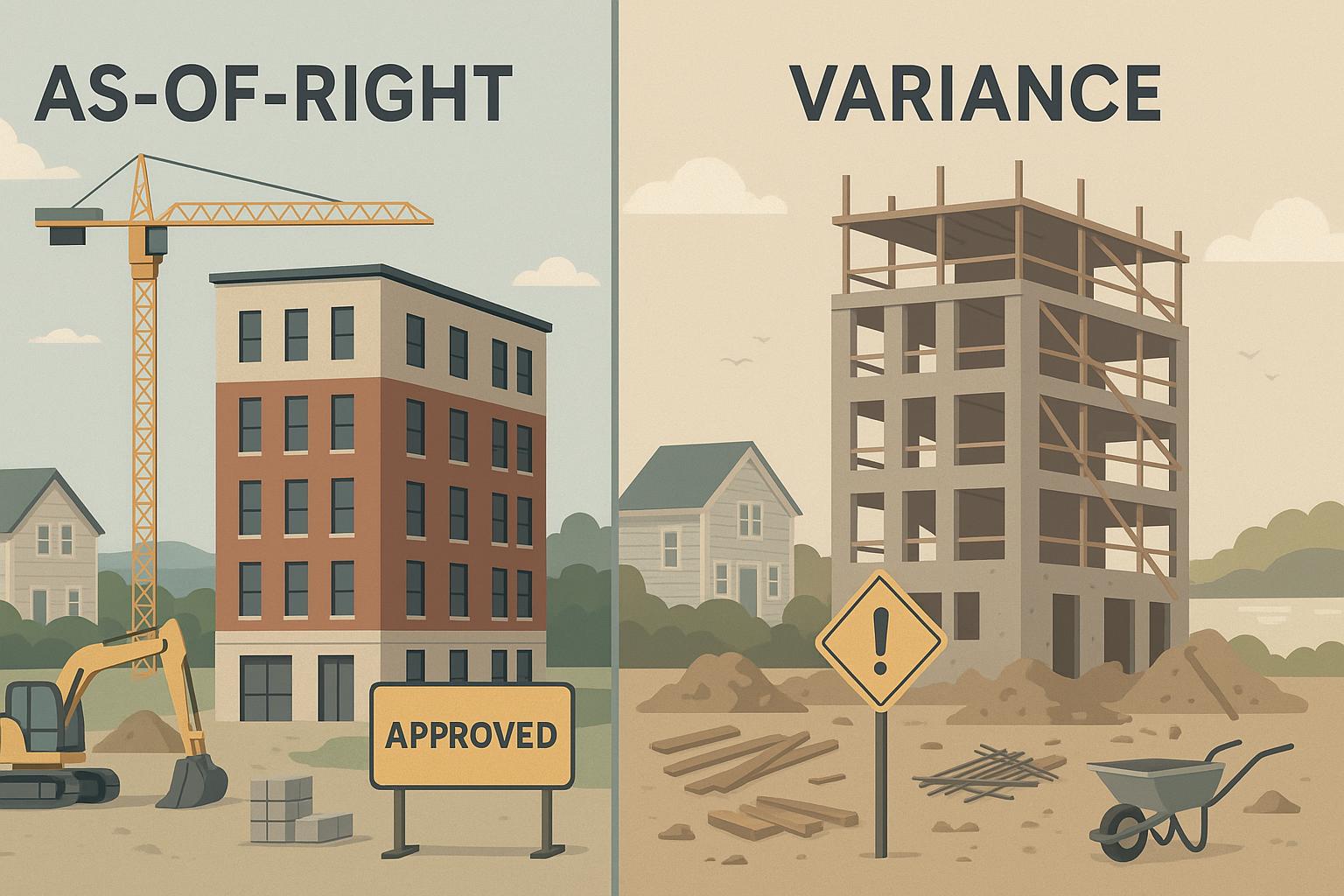Want to build in HR-1 zones and exceed 2,000 m² of Gross Floor Area (GFA)? Here's what you need to know:
- Bonus zoning lets you build bigger, but you must provide public benefits like affordable housing or community amenities.
- Threshold: Public benefit requirements apply to any GFA above 2,000 m².
- Contribution Formula: 20% of the GFA exceeding 2,000 m² is used to calculate your required public benefit contribution.
- Cost Example: For a 15,000 m² project, the excess 13,000 m² is multiplied by $186.75, with 60% going to affordable housing and 40% to other benefits.
Key Takeaways:
- Plan early to include public benefit costs in your budget.
- Choose integrated construction methods to streamline compliance and avoid delays.
- Fixed-price contracts help control costs and timelines, improving your return on investment (ROI).
Meeting HR-1 zoning requirements can be complex, but with proper planning and coordination, your project can stay profitable and compliant.
Public Benefit Requirements for HR-1 Projects
Types of Required Public Benefits
When an HR-1 project surpasses 2,000 m² of gross floor area (GFA), Halifax mandates that property owners provide public benefits to address community needs and balance the increased demand on services. These benefits generally fall into two main categories: affordable housing initiatives and community amenity projects.
Property owners have some flexibility in how they meet these obligations. For instance, you could incorporate qualifying features into your development, contribute to off-site community initiatives, or make a cash-in-lieu payment, allowing the municipality to fund broader community improvements.
The following section explains how these contributions are calculated and delivered.
How to Calculate and Deliver Public Benefits
Municipal guidelines outline a formula to determine the required public benefit contributions for any GFA that exceeds 2,000 m². The exact calculation and rates depend on local planning policies, so it’s important to consult municipal documentation or speak with planning staff to ensure accuracy.
There are typically several ways to deliver these benefits:
- Direct Provision: Include eligible amenities or affordable housing units directly within your project design.
- Off-Site Provision: Contribute to community projects elsewhere if on-site integration isn’t feasible.
- Cash-in-Lieu Payments: Offer a monetary contribution that the municipality can use for community-wide improvements.
The timing of these contributions is often tied to key project milestones, such as obtaining development approvals or before final occupancy permits are issued.
This system works in tandem with municipal oversight, which is detailed in the next section.
Compliance Rules and Municipal Authority
Municipal authorities are responsible for enforcing public benefit requirements under provincial planning laws and local land use by-laws. During the development approval process, planning staff will review your public benefit plan to ensure it aligns with local priorities and regulations.
Compliance checks occur at various stages, from initial site plan approval to final occupancy, to confirm that the agreed-upon benefits have been delivered. Developers may also need to provide security measures, such as deposits or letters of credit, to guarantee their commitments.
To avoid delays, keep detailed records of your GFA calculations and benefit delivery. Early coordination with municipal staff and working with professionals familiar with local planning policies can help ensure your project meets all requirements efficiently.
Compliance Guide for Property Owners
Application Steps and Approval Timeline
Now that public benefit calculations are clear, property owners must follow a detailed application process to ensure their community contributions align with project milestones.
For HR-1 projects that exceed 2,000 m² of Gross Floor Area (GFA), a Planning Application is mandatory instead of a standard building permit. This process is managed through either a Development Agreement or a Land-Use By-law Amendment [1]. To get started, reach out to your local municipal planning office to arrange an initial review and submit the required documents. Depending on the complexity of your project, the approval process can take anywhere from 3 to 6 months.
Construction Approaches: Fragmented vs Integrated
Fragmented vs Integrated Construction Methods
The way a construction project is approached can have a major impact on its success, especially when public benefit requirements come into play. These requirements often add layers of complexity, influencing both timelines and budgets. In a fragmented construction model - where architects, engineers, planners, and contractors operate independently - coordination challenges tend to escalate, making it harder to meet these obligations.
Globally, 90% of construction projects face cost overruns and delays [8]. Poor communication and inadequate planning are two of the biggest culprits [7]. When you’re juggling public benefit calculations, municipal approvals, and tight construction deadlines, a fragmented approach can magnify risks at every turn.
| Aspect | Fragmented Construction | Integrated Construction |
|---|---|---|
| Accountability | Responsibilities are divided, often leading to blame-shifting [2][4] | Centralized accountability with shared responsibilities [3][6] |
| Budget Certainty | Frequent cost overruns due to rework and late design changes [2][4] | Fixed pricing enabled by early collaboration [2][5] |
| Timeline Reliability | Delays and scheduling conflicts are common [2][4] | Better timeline adherence through improved coordination [2][5] |
| Public Benefit Compliance | Difficult to manage due to poor communication and disputes [2][4] | Simplified compliance through proactive planning [3][5] |
| Communication | Inefficient and inconsistent | Continuous feedback and systematic decision-making [2][3] |
One of the biggest issues with fragmented construction is the isolation of key players. Architects, engineers, and contractors often work in silos, with little coordination between them. This lack of collaboration has been identified as the top fragmentation issue across 27 industry studies [4]. It becomes even more problematic when projects must meet both building code requirements and public benefit obligations, such as affordable housing or community amenities.
Fragmentation also leads to sequential workflows that further delay progress [4]. For example, architects complete their designs before handing them off to engineers, who then pass them to contractors. By the time construction begins, the original intent behind key design decisions may be forgotten, complicating efforts to align with public benefit requirements.
These challenges highlight the need for an integrated approach, which offers a more coordinated solution.
How Integrated Builders Handle Public Benefit Requirements
Integrated construction methods bring design, compliance, and execution together from the very start, ensuring public benefit requirements are tackled proactively. Rather than viewing these requirements as obstacles, integrated teams treat them as opportunities to enhance the project’s overall value. By involving architects, engineers, planners, and construction teams early on, they can seamlessly incorporate public benefit strategies into the design and planning phases, avoiding the need for last-minute adjustments.
Early stakeholder involvement is particularly important for complex projects [2][5]. Integrated teams can address potential conflicts - like balancing building designs with affordable housing commitments - during the initial stages. For instance, modifying unit layouts or site designs early can help maximize rental income while meeting public benefit obligations.
A single, experienced Project Manager plays a crucial role in this approach [8]. Research shows that nine out of ten projects fail due to poor project management [8]. By centralizing accountability, a skilled manager ensures that construction logistics and municipal requirements are handled cohesively, reducing the finger-pointing that often arises as deadlines loom.
Integrated builders also align public benefit deliverables with construction milestones through upfront planning [3]. Instead of treating requirements like affordable housing or community spaces as separate, afterthought obligations, these elements are woven into the overall construction schedule. This approach minimizes delays and avoids penalties from municipal authorities.
Regular updates and systematic decision-making help catch potential conflicts early, reducing the need for costly changes later [2][3].
Financially, the benefits are significant. Cost overruns can devastate a contractor’s bottom line, sometimes even leading to bankruptcy [9]. With fixed-price contracts and integrated planning, builders can better manage risks, providing greater budget certainty - even when public benefit requirements add complexity to a project.
sbb-itb-16b8a48
Costs and Returns for Property Owners
Public Benefit Costs and Budget Impact
Public benefit obligations - like affordable housing, community amenities, and infrastructure upgrades - can add significant expenses to your construction budget if not accounted for early on. To avoid financial surprises, it's crucial to factor these costs into your initial planning and estimates. This proactive approach helps you stay on budget and maintain control over your finances.
Now, let’s look at how these costs influence the overall return on investment (ROI) for HR-1 projects.
ROI Calculations for HR-1 Projects
To calculate ROI for HR-1 projects, you need to include all cost components - such as the purchase price, construction expenses, financing, carrying costs, and public benefit obligations - alongside revenue streams like cash flow, mortgage principal reductions, and property value appreciation.
Here’s an example: A 16-unit project with a fixed construction cost of $160,000 per unit and monthly rents of about $1,950 per unit generates an annual gross income of approximately $374,400. After deducting expenses (typically 35–40%), the net operating income comes to around $225,000. Using leveraged financing, such as a 25% down payment, can further enhance these returns.
Over time, additional factors like mortgage principal reductions and property appreciation contribute to long-term profitability. In Canada, properties with steady ROI have been shown to outperform REITs by around 23% in maintaining value over time [10].
By effectively integrating all costs early in the process, you can ensure that public benefit requirements don’t eat into your project’s profitability. This thorough financial planning also highlights the advantages of adopting a fixed-price construction model.
Fixed-Price Construction Benefits
A fixed-price construction model provides certainty by locking in costs upfront and accounting for all known requirements. This eliminates risks like unexpected change orders or scope creep, which are common in less structured approaches.
This model allows for more accurate ROI projections from the beginning. With fixed costs and streamlined timelines, property owners can secure better financing terms, reduce carrying costs during construction, and ultimately enjoy stronger, more predictable returns on their investment.
Delays in construction can lead to significant losses in rental income. For instance, a delay of just one month for a 16-unit project renting at $1,950 per unit could mean a loss of $31,200 in potential revenue. Financial penalties tied to schedule overruns ensure contractors share the risk, encouraging timely project completion and protecting your bottom line.
Key Points for Property Owners
If your project exceeds 2,000 m² of gross floor area, understanding HR-1 bonus zoning requirements is a must. Planning ahead can save you from costly setbacks and help ensure your development meets municipal obligations while staying profitable.
Once your project crosses the 2,000 m² threshold, you’ll need to account for public benefit requirements. These could include contributions like affordable housing, community amenities, or infrastructure upgrades. Budgeting for these from the start is crucial to avoid unexpected financial challenges and maintain control over your project.
How you approach construction plays a big role in meeting these obligations. Integrated construction methods simplify coordination across professionals. Traditional, fragmented approaches often lead to miscommunication, especially when it comes to public benefit requirements. This can cause delays and cost overruns. By aligning planners, architects, engineers, and construction teams from the outset, you make compliance more straightforward and predictable.
Fixed-price construction models also offer a significant advantage. They lock in costs and timelines, giving you a clear picture of your investment, including compliance expenses. This level of predictability is especially valuable when navigating HR-1 regulations, where delays can directly impact your bottom line.
Delays can be expensive. For instance, a 16-unit project renting at $1,950 per unit monthly loses $31,200 in revenue for every month it’s delayed. Working with construction companies that guarantee completion dates - and even impose financial penalties for delays, such as $1,000 per day - can help protect your income and manage risks.
The secret to HR-1 success is integrating public benefits into the project design from the start. Treating these requirements as a core part of your strategy not only ensures compliance but also helps secure a strong return on investment (ROI). Experienced teams familiar with bonus zoning requirements can help you avoid common pitfalls, keeping your project on track to deliver the 12-20% annual ROI that makes these developments so appealing.
HR-1 projects require expertise in planning, engineering, and construction coordination. Partnering with professionals who excel in integrated construction ensures your project meets regulatory demands while delivering strong financial results for multi-unit residential developments.
FAQs
What public benefits are required when an HR-1 project exceeds 2,000 m² of Gross Floor Area (GFA)?
When an HR-1 project exceeds 2,000 m² of Gross Floor Area (GFA), property owners must provide certain public benefits. These often include contributions toward affordable housing, community amenities like parks or recreational spaces, or other types of public infrastructure. The specific requirements are guided by local land use bylaws, aiming to improve the community while encouraging responsible development.
For property owners, being aware of these obligations is crucial for staying compliant and making the most of their development project. Reviewing local regulations and consulting experts can help clarify these requirements and make the process smoother.
How can property owners plan for public benefit costs when developing projects over 2,000 m² of GFA in HR-1 zones?
To plan effectively for public benefit costs, property owners should account for these contributions right from the initial budgeting phase. In HR-1 zones, developments with more than 2,000 m² of gross floor area (GFA) may need to include public benefits such as affordable housing or community amenities. Identifying these obligations early can help avoid unexpected costs and maintain the project's financial viability.
Connecting with municipal planning officials during the early stages of development is crucial. This step helps clarify specific requirements, allowing for better allocation of funds and more accurate financial planning. Taking the time to review local policies and potential charges also ensures compliance while helping to manage costs and improve overall project returns.
What are the benefits of using integrated construction methods to meet HR-1 zoning requirements in Canada?
Integrated construction methods offer a practical way to address HR-1 zoning requirements, particularly when public benefit obligations come into play for developments exceeding 2,000 m² of Gross Floor Area (GFA). By merging design and construction into a unified, coordinated process, these methods help cut down on delays, reduce miscommunication, and avoid expensive rework.
This streamlined approach leads to improved quality control, shorter project timelines, and more predictable costs. It not only helps property owners meet zoning regulations but also allows them to make the most of their development opportunities. Additionally, integrated methods simplify the often complex process of fulfilling public benefit requirements - like creating affordable housing or adding community amenities - by ensuring a smoother transition from planning to project completion.



